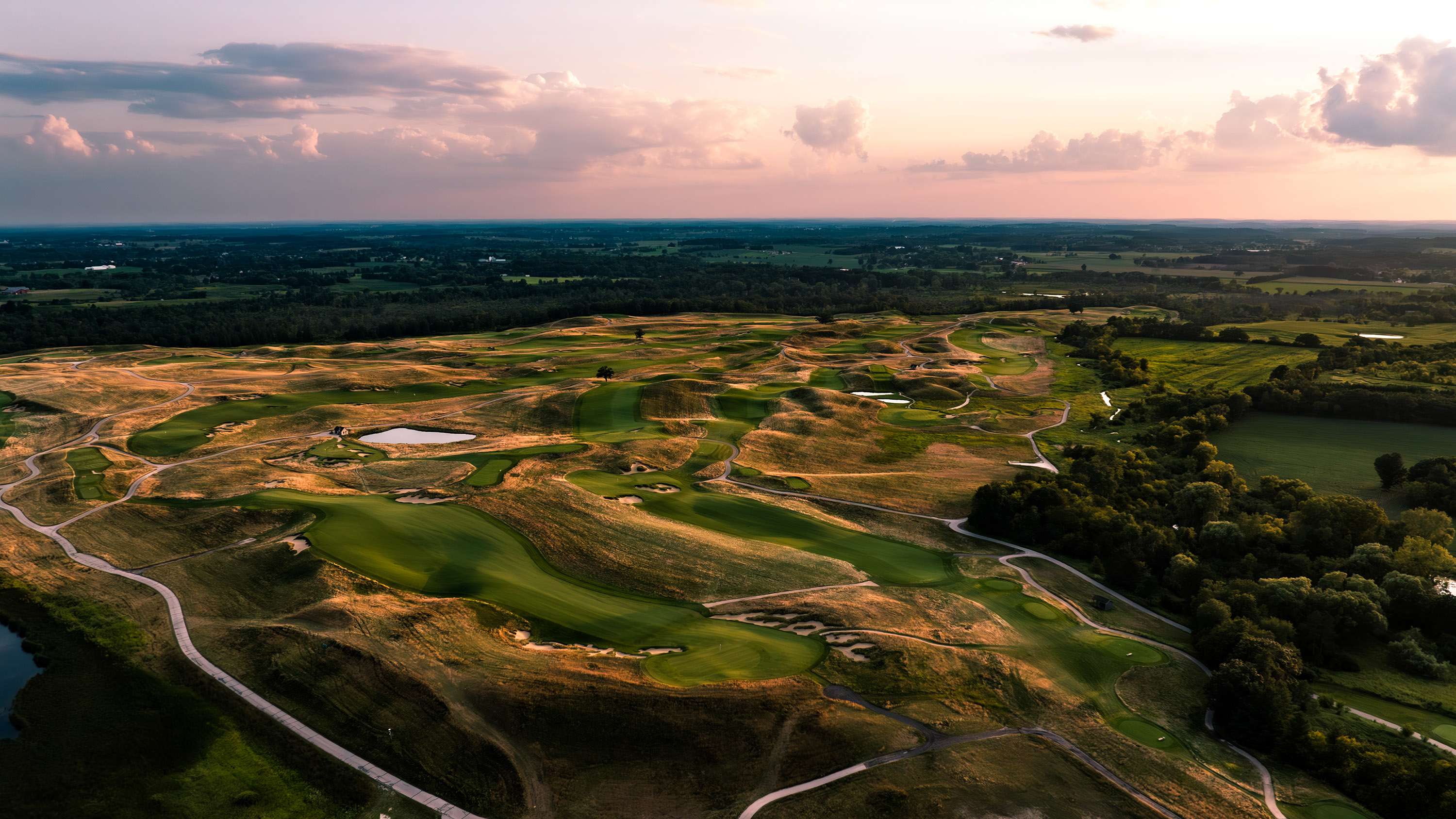Erin Hills
A relative newcomer to championship golf, Erin Hills burst onto the scene in the early part of the 21st century by hosting three USGA championships. In fact, it was awarded the 2008 U.S. Women's Amateur Public Links before it even opened to the public. The daily-fee course then hosted the 2011 U.S. Amateur, won by Kelly Kraft in a memorable duel over future multi-PGA Tour winner Patrick Cantlay. And six years later, Brooks Koepka claimed the first of his two consecutive U.S. Open titles. In 2022, Matthew McClean, of Northern Ireland, edged good friend Hugh Foley, of the Republic of Ireland, to win the U.S. Mid-Amateur. That set the stage for the world's best females to challenge the links-style layout just outside of Milwaukee.
Hole 1
This mid-length par 5 will ease players into their round. While the wetland down the left side may be intimidating, the player will have a generous landing area to a fairway that measures 50 yards wide. From here players will have a decision to make, cut the corner (and risk hitting into the wetland) a bit to run the ball onto the green or layup to about 75 yards, short of the bunker complex and a flatter lie for their 3rd shot. Controlling ball flight and spin into this green that slopes front to back and right to left will be key to getting off to a good start.
Hole 2
This short par 4 poses a strategic question off the tee. The player can choose to play to the visible side of the fairway (right) short of the bunker complex and have a blind approach shot to the smallest green on course or play to the left side of the fairway (blind from the tee) to have the best angle of approach. From either side, the player will have a wedge into another green that slopes slightly front to back and right to left. Recovery shots could be challenging based on that particular day’s hole location.
Hole 3
This dramatic par 4 is perched up high on a dune. Given the strong right to left contour of the drive zone landing area, the ideal line of play is left edge of the right fairway bunker complex. Otherwise, avoiding the left fairway bunker complex will be challenging. The approach will be especially daunting from an uneven lie to a blind putting surface. The long central bunker in the front of the green will play with the player’s depth perception, however there is 12 yards between the central bunker edge and the putting green, allowing the player to use that area to bounce the ball onto the green. This “starfish” green will present its own challenges. Players making par or better will likely gain strokes on the field. At the 2017 U.S. Open, this hole played the hardest for the week.
Hole 4
This mid-length par 4 should not be underestimated. The player will be playing from another elevated tee but to a semi-blind landing area. It will be key to avoid the right fairway bunker that is 8 feet deep! The player will be left with a slightly uphill approach with another long central bunker to carry that is adjacent to a wide and narrow green. Distance control will be critical as a shot missed long will be met with a steep shaved bank that leads to a wetland. This hole played second most difficult at the 2017 U.S. Open.
Hole 5
The key to playing this long par 4 is placing an accurate tee shot left center of the fairway, avoiding the newly added fairway bunker on the left. A tee shot headed to the right will be punished by a long and blind approach. While this is the third hole in a row where the player will need to navigate another long central bunker, the putting green is fairly mild and larger that the two previous par 4’s and the player will be able to use the architecture on the left side of the putting green to funnel the ball to the hole if she chooses.
Hole 6
The longest par-3 for the championship is slightly uphill to an infinity green that slopes front to back. With countryside in the distance, this tee shot may be a litle unnerving. The putting surface is the deepest on course, surrounded by closely mown areas. A missed shot long will likely provide a fairly simple uphill recovery shot.
Hole 7
This strong par-5 will require accuracy off the tee to place the ball between the two sets of fairway bunker complexes on either side of the fairway. Players will then need to decide how far they want to lay up avoiding the strategically placed bunkers in the second landing area. With a short blind approach, players will be faced with a putting green with a spine down the middle that slopes back to front and left to right. A shot missed short right will be faced with a tough recovery as the ball will likely come back to about 50 yards for a pitch back up the hill.
Hole 8
This true dogleg left par 4, is slightly uphill and blind off the tee to a reverse camber fairway. Choosing the right line off the tee, cutting off some of the corner will be required to likely keep the ball in the fairway. The shallow green will play deeper than the 26-yard depth due to the “catcher’s mit” designed complex. Missing short of this green, players will be lucky if their ball catches one of the three fronting bunkers. If not, the ball will likely funnel back to approximately 70 yards for another blind recovery shot.
Hole 9
This short par-3 should not be underestimated. Noted as the “shortest par-5 in Wisconsin” by local caddies, wind will play a key factor on this dramatically downhill tee shot (-8) to a small target that possesses a false front and front to back/left to right sloping surface. Recovering from a left side bunker could be quite challenging. A par or better is an extremely good score on this short, but mighty finishing hole on the outward nine.
Hole 10
While players will be presented with another blind tee shot, it is to the widest drive zone landing area on course at almost 75 yards. However, players may want to play strategically off the tee given that day’s hole location. A hole location on the right side of this two-tiered green with a spine down the middle would be better played from the left side of the fairway with a better angle and view of the hole, despite having a slightly longer club into the green. While a smaller target, that side of the putting surface is also a bit more forgiving with the natural backstop behind it. Conversely, a hole location on the left side of the green would be better suited to be played down the right side (punch bowl) side of the fairway.
Hole 11
Despite the players being presented with another blind tee shot, this mid-length par 4 has a forgiving fairway contour. With a short iron in hand on this uphill approach, the player can use the slope of the closely mown area on the left side of the green, if desired to funnel the ball to the hole.
Hole 12
This shorter par-4 presents a unique tee shot opportunity. The forced carry is approximately 200 yards, but it will be important to hug the right side fairway line to ensure the ball funnels into the fairway on the opposite side of the tabletop slope. Players should have a very short club in their hand on the approach that will likely be at least semi-blind, only seeing the top of the flagstick. Distance control will be key to a fairly narrow green that slopes middle to front and middle to back.
Hole 13
This mid-length par-3 will require an accurate shot and one with great distance control due to the small valley on the left side of the putting surface and the slightly crowned nature of the green. It could be a multiple club green depending on the hole location and wind. An offline approach will be propelled further from the green due to the closely mown slopes coming off every side of the putting complex. The left greenside bunker was naturally formed after many Hawthorn bushes were removed, but the front left pot bunker was man-made paying homage to the infamous pit on the 10th hole at Pine Valley.
Hole 14
The first of 2 par-5’s on the back nine provides a risk/reward option off the tee. While all players will likely be able to carry the long central bunker in the middle of the fairway (221 carry), some players may try to take a slightly more aggressive line cutting the corner over the left fairway bunker (238 carry) to get further down the hole and not hit through the fairway on the opposite side. Depending on the player’s tee shot placement, it may also present an opportunity to go for the green in two. That approach will be slightly uphill and player’s will need to be sure to navigate the false front staring them in the face. If successful, the topography on the backside of the green is very player friendly and will likely funnel the ball back onto the putting green.
Hole 15
This short par-4 could provide some unique risk/reward opportunities. With strategically placed bunkers, slight reverse camber fairway and rolling terrain, this fairway could be harder to hit than it appears. Players will have a wedge in their hand on this approach to a “volcano” like green. A left hole location will be better played from the right side of the fairway and vice versa. While the left side of the green is “bowl-like”, the right side of the green slopes middle to front and middle to back, creating additional challenge putting. Like many other holes at Erin Hills, players will be faced with a tough recovery if she misses the putting surface.
Hole 16
This strong par-3 will present a good challenge on the third-to-last hole of the round. The shape of the teeing area is an interesting one as depending on the tee placement the hill on the left side could obstruct the view of part of the putting green and the flagstick, not to mention the left greenside bunkers. A strong mid-to-long iron or hybrid will be required to this deep putting green that is bisected by a ridge. Placing the ball on the proper level as the hole will be key to a possible birdie.
Hole 17
The only hole with no bunkers, this demanding par-4 should not be underestimated. With another blind tee shot landing area, the architecture favors a right center tee shot giving the most favorable look at the green. From that angle, with players having a long iron/hybrid into this green, players may be able to use the approach to bounce the ball onto the green if they so choose to a left hole location. A tee shot from the left side of the fairway will have a somewhat blind approach given the green is tucked behind a ridgeline.
Hole 18
On this iconic closing Par 5, with 23 strategically placed bunkers and challenging green, players will have a choice to make off the tee, lay back to of the set of cross bunkers giving them width in the fairway or thread a tee shot inside the cross bunkers to a 25-yard fairway getting further down the hole. The second shot may also require a decision to lay up short of the central bunker sitting approximately 100 yards out or take it on to have a better approach angle and view of the putting green. A missed shot short will likely be an easier recovery vs. going over the green. The setup of this final hole could provide an exciting finish to the U.S. Women's Open.














